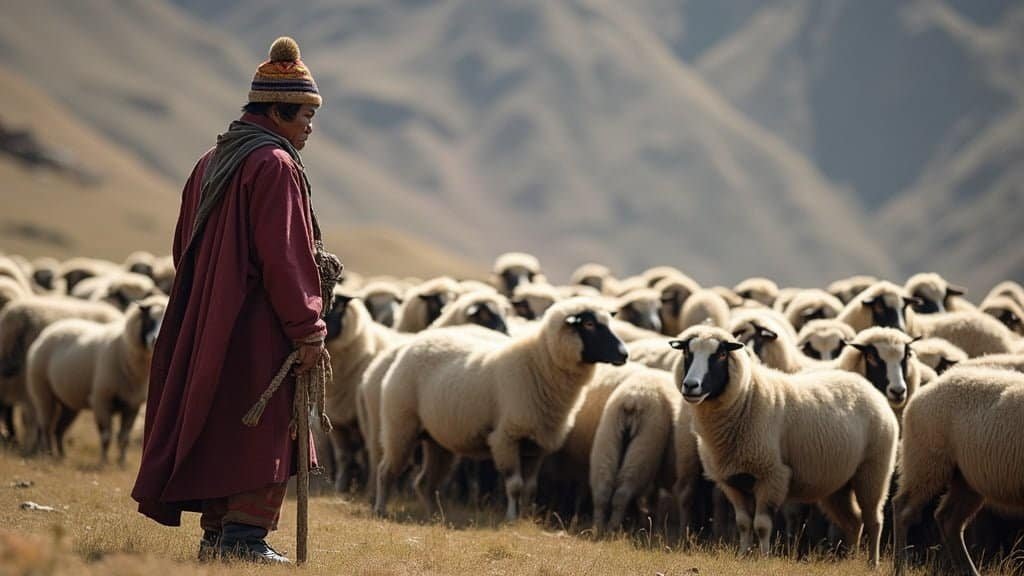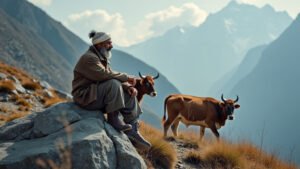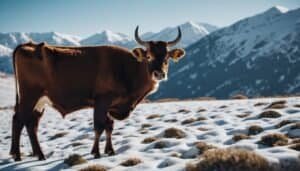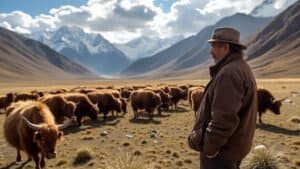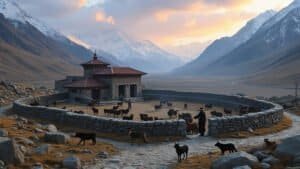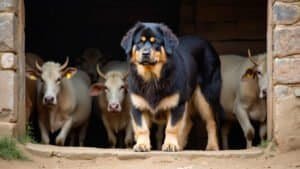Introduction
Living alongside snow leopards in remote mountainous regions presents unique challenges for local communities. These elusive predators, though vital to the ecosystem, pose a significant threat to livestock, leading to economic hardship and conflict
This article explores the strategies communities use to protect their animals, the economic impact of snow leopard attacks, and the role of conservation efforts in mitigating human-wildlife conflict
Additionally, we will examine how these communities balance the need to preserve this endangered species with their own survival, highlighting the importance of sustainable solutions and government support
Strategies for Protecting Livestock from Snow Leopards
Communities living in regions inhabited by snow leopards often face the challenge of protecting their livestock from these powerful predators. Snow leopards, with their stealth and strength, can take down animals much larger than themselves, making them a significant threat to the livelihood of herders
However, over centuries, these communities have developed a range of strategies to mitigate these attacks while coexisting with this endangered species. The approaches vary from traditional methods passed down through generations to modern innovations aimed at safeguarding livestock without harming the snow leopards
Traditional Livestock Guarding Techniques
Historically, many communities have relied on traditional livestock guarding techniques to protect their animals from snow leopards. One common practice involves keeping livestock in enclosed corrals or pens made of stone or wood, especially during the night when attacks are more likely
These enclosures, often situated near the herder’s home, are designed to be sturdy and difficult for a predator to penetrate. In some regions, the use of livestock guardian dogs, such as the Tibetan Mastiff, has been a crucial deterrent
These large, protective dogs are trained to stay with the herd and ward off potential predators, including snow leopards, through barking and aggressive displays
Another traditional method involves rotational grazing, where herders move their livestock between different pastures to reduce the risk of snow leopard encounters. This technique not only provides fresh grazing areas but also keeps the livestock from staying in one place too long, making it harder for predators to track and ambush them
Additionally, herders often stay with their flocks during grazing to monitor and protect them, sometimes using noise-making devices like bells or whistling to deter predators
Use of Non-Lethal Deterrents
In recent years, non-lethal deterrents have become increasingly popular as a means of protecting livestock without endangering snow leopards. These methods are particularly favored in areas where conservation efforts are strong, and the local community is committed to preserving the endangered cat
One such deterrent is the use of light and sound devices, which are set up around livestock enclosures to startle and scare away approaching predators. Motion-activated lights or alarms create an unpleasant experience for snow leopards, reducing the likelihood of repeated attacks
Another innovative approach is the use of predator deterrent collars. These collars, fitted with spikes or reflective materials, are worn by livestock, making it more difficult for a snow leopard to make a successful kill
The reflective materials can disorient predators at night, while the spikes protect vulnerable areas like the neck. In some regions, herders have also employed the use of “fox lights,” which are solar-powered lights that flash intermittently, mimicking the presence of humans and scaring away snow leopards
Implementation of Predator-Proof Enclosures
Predator-proof enclosures are perhaps the most effective method for preventing snow leopard attacks on livestock. These enclosures are designed with robust materials such as metal or reinforced wood, often with roofs to prevent leopards from jumping in
In some cases, electric fencing is added to the perimeter, providing an additional layer of security. These enclosures are particularly useful during the night or in winter months when snow leopards are more active and food is scarce
Organizations like the Snow Leopard Trust and Panthera have been instrumental in helping communities construct predator-proof enclosures
These NGOs often provide both the materials and training needed for local communities to build and maintain these structures. The success of these enclosures has been significant, with some areas reporting a drastic reduction in livestock losses after their implementation
In addition to physical barriers, some communities have also adopted early warning systems. These systems include motion sensors or cameras that alert herders when a snow leopard is near, allowing them to take immediate action to protect their livestock. Such systems not only help prevent attacks but also contribute to better monitoring of snow leopard movements, aiding in their conservation
Economic Impact of Snow Leopard Attacks
Snow leopard attacks on livestock can have profound economic consequences for local communities, particularly in remote mountainous regions where alternative sources of income are limited
These attacks not only result in the immediate loss of valuable livestock but can also have a cascading effect on the financial stability and resilience of the affected households
Understanding the economic impact of these predations is crucial in addressing the broader human-wildlife conflict and developing sustainable solutions that support both community livelihoods and snow leopard conservation
Financial Losses Due to Livestock Predation
The most direct economic impact of snow leopard attacks is the loss of livestock, which often constitutes the primary source of income for herding communities
In regions like the Himalayas, Altai, and the Pamirs, livestock such as sheep, goats, yaks, and horses are vital for subsistence, providing food, wool, and trade goods. When a snow leopard kills one of these animals, the herder not only loses a source of income but also faces reduced productivity in terms of milk and wool, and potentially a loss in breeding stock
The financial burden is especially heavy in poorer communities where herders own only a small number of animals. For these households, losing even one animal can represent a significant portion of their annual income
Studies have shown that in some regions, a single snow leopard attack can wipe out 10-15% of a household’s livestock . The cumulative effect of repeated attacks can push families into poverty, making it difficult for them to recover financially
The Role of Compensation Programs
To mitigate the financial losses suffered by herders, various compensation programs have been established by governments, NGOs, and conservation organizations
These programs aim to reimburse herders for livestock lost to snow leopard predation, thus providing a safety net that helps maintain economic stability in affected communities. Compensation schemes vary in their structure, with some offering direct cash payments, while others provide livestock replacements or subsidies for improved animal husbandry practices
One of the most well-known compensation programs is run by the Snow Leopard Trust, which operates in several countries across Central Asia
This program not only compensates herders but also requires them to adhere to specific conservation-friendly practices, such as not killing snow leopards in retaliation for attacks . By tying compensation to conservation, these programs help reduce human-wildlife conflict while ensuring that herders are not left destitute by livestock losses
However, the success of compensation programs depends on timely and fair assessments of livestock losses, as well as adequate funding. Delays in payments or disputes over the cause of death can undermine the effectiveness of these programs and erode trust within the community
Additionally, compensation alone may not be sufficient to cover the full economic impact, especially if the loss of livestock leads to broader economic challenges such as reduced income from wool or dairy products
Long-Term Economic Consequences for Communities
Beyond the immediate financial losses, snow leopard attacks can have long-term economic consequences for communities. Persistent predation can lead to a reduction in herd sizes, which in turn affects the overall productivity and sustainability of the livestock-based economy
This reduction can result in a downward spiral where herders are forced to sell off remaining animals at lower prices or reduce their reliance on livestock altogether, potentially leading to the abandonment of traditional herding practices
In some cases, the fear of repeated attacks may prompt herders to overgraze safer pastures near their homes, leading to environmental degradation and further economic strain
Overgrazing can reduce the quality of the pastureland, decreasing its ability to support livestock and leading to lower yields over time. This environmental impact, coupled with the economic losses, can make it increasingly difficult for communities to maintain their livelihoods in the long term
Furthermore, the psychological impact of living with the constant threat of snow leopard attacks can also affect economic decision-making
Herders may invest less in their livestock or be reluctant to adopt new practices that could increase productivity but also heighten the risk of predation. This cautious approach can limit economic growth and resilience, trapping communities in a cycle of poverty and dependence on external assistance
Conservation and Human-Wildlife Conflict
The relationship between snow leopard conservation and human-wildlife conflict is complex and multifaceted. As communities strive to protect their livestock from predation, there is an inherent tension between the need to safeguard their livelihoods and the global imperative to preserve snow leopards, an endangered species
Effective conservation efforts must therefore balance these competing interests, fostering coexistence rather than conflict. This section explores various approaches to conservation that address human-wildlife conflict, emphasizing community involvement and collaboration
Community-Based Conservation Initiatives
Community-based conservation initiatives are among the most effective strategies for addressing human-wildlife conflict in snow leopard habitats
These initiatives engage local communities as active participants in conservation efforts, recognizing that those who live closest to snow leopards are best positioned to protect them. By involving communities in decision-making processes, conservation organizations can develop solutions that are not only ecologically sound but also culturally appropriate and economically viable
One successful example of community-based conservation is the “Snow Leopard Enterprises” program, run by the Snow Leopard Trust. This program provides training and resources to local artisans, enabling them to produce and sell handicrafts made from wool and other local materials
In return, participating communities agree to protect snow leopards and their prey species. The income generated through this program reduces the economic incentive to retaliate against snow leopards for livestock losses, while also promoting sustainable livelihoods
Another example is the establishment of community-managed wildlife reserves. In regions like the Tost Mountains of Mongolia, communities have collaborated with conservationists to create protected areas where snow leopards can thrive without posing a direct threat to livestock
These reserves are managed by local people, who monitor snow leopard populations and enforce regulations that minimize human-wildlife conflict. Such initiatives not only protect snow leopards but also empower communities by giving them a stake in the conservation process
Education and Awareness Programs
Education and awareness programs are crucial for reducing human-wildlife conflict and fostering a culture of coexistence. These programs aim to increase understanding of snow leopards and their ecological role, dispelling myths and misconceptions that often lead to fear and hostility
By educating communities about the importance of snow leopards and the benefits of conservation, these programs can help shift attitudes and encourage more positive interactions with wildlife
In many snow leopard habitats, conservation organizations conduct workshops, school programs, and community meetings to educate people about the species and the challenges it faces
These programs often include information on the ecological role of snow leopards as apex predators, their behavior, and the reasons behind their predation on livestock. By providing this knowledge, educators can help communities better anticipate and prevent conflicts with snow leopards
Moreover, education programs often emphasize the benefits of non-lethal deterrents and improved livestock management practices. By demonstrating the effectiveness of these methods, such programs can reduce the reliance on harmful practices like poisoning or trapping snow leopards
In some cases, communities are also taught how to use technology, such as camera traps or GPS collars, to monitor snow leopard movements, enabling them to take proactive measures to protect their livestock
Collaboration Between NGOs and Local Communities
Collaboration between non-governmental organizations (NGOs) and local communities is essential for the success of conservation efforts aimed at mitigating human-wildlife conflict
NGOs bring expertise, resources, and global perspectives to conservation, while local communities contribute invaluable knowledge of the landscape, wildlife behavior, and cultural practices. When these two groups work together, they can develop innovative solutions that address both conservation goals and community needs
One notable example of such collaboration is the Global Snow Leopard & Ecosystem Protection Program (GSLEP), which involves partnerships between governments, NGOs, and local communities across the snow leopard’s range
This initiative promotes landscape-level conservation planning, ensuring that snow leopards have sufficient habitat to thrive while also supporting sustainable development for local people. Through GSLEP, local communities are engaged in activities such as habitat restoration, anti-poaching patrols, and monitoring of snow leopard populations, all of which contribute to reducing conflict and enhancing conservation outcomes
Another form of collaboration is the integration of traditional ecological knowledge into conservation planning. Many indigenous communities in snow leopard habitats have long histories of coexisting with these predators, and their knowledge of the environment and animal behavior can greatly enhance conservation strategies
NGOs working in these areas often consult with community elders and incorporate traditional practices, such as seasonal grazing patterns and wildlife-friendly herding techniques, into their conservation plans. This approach not only respects the cultural heritage of local communities but also leverages their expertise to create more effective conservation strategies
Balancing Conservation with Livelihoods
Balancing the conservation of snow leopards with the livelihoods of local communities is a delicate and complex challenge. For many people living in snow leopard habitats, livestock rearing is not just a way of life but also a vital source of income
On the other hand, snow leopards are an endangered species, and their survival is critical to maintaining the ecological balance in these regions
This section examines how sustainable livelihood alternatives, government policies, and the ongoing challenges in maintaining this balance play a role in ensuring both the survival of snow leopards and the well-being of human communities
Sustainable Livelihood Alternatives
To reduce the economic reliance on livestock, which is often at risk from snow leopard predation, several programs have been developed to provide sustainable livelihood alternatives for local communities
These alternatives aim to diversify income sources, making communities less vulnerable to the economic shocks caused by livestock losses. Moreover, by providing alternative income opportunities, these initiatives can help reduce the pressure on natural resources and create a more harmonious relationship between people and wildlife
One approach involves the promotion of eco-tourism in snow leopard habitats. Eco-tourism allows communities to benefit financially from the presence of snow leopards by attracting tourists who are interested in wildlife and nature
In regions like Ladakh in India, local communities have been trained to host tourists, guiding them on wildlife safaris and educating them about snow leopard conservation. The revenue generated from eco-tourism is often reinvested into community development projects and conservation efforts, creating a positive feedback loop that benefits both people and wildlife
Another alternative is the development of handicrafts and other locally made products that can be sold in domestic and international markets. Programs like the Snow Leopard Trust’s handicraft initiative train local artisans to create high-quality products such as felt rugs, woolen clothing, and other crafts
These products are sold through various channels, with a portion of the proceeds going directly to the artisans and the rest supporting conservation projects. By providing a steady income, these programs reduce the economic pressure on herders and help to foster a sense of pride and ownership in conservation efforts
Government Support and Policies
Government support is crucial in balancing conservation with livelihoods, as effective policies and programs can create an enabling environment for both snow leopard protection and community development
In many snow leopard range countries, governments have implemented policies that support sustainable livelihoods, protect critical habitats, and involve local communities in conservation planning
For instance, in Nepal, the government has established conservation areas and national parks that not only protect snow leopard habitats but also provide opportunities for local communities to participate in eco-tourism and sustainable resource management
In these protected areas, communities often have access to resources like timber and medicinal plants, which they can harvest sustainably. In return, they are expected to protect wildlife and refrain from activities that could harm snow leopards, such as poaching or habitat destruction
Moreover, some governments provide direct financial incentives for conservation, such as subsidies for predator-proof enclosures or compensation for livestock losses. These incentives are designed to reduce the economic impact of snow leopard predation while encouraging communities to engage in conservation activities
Additionally, government-sponsored education programs raise awareness about the importance of snow leopards and the benefits of conservation, helping to build public support for these efforts
Challenges in Maintaining Balance
Despite the progress made in balancing conservation with livelihoods, several challenges remain. One of the most significant challenges is the limited financial resources available to support both community development and snow leopard conservation
In many snow leopard range countries, economic constraints make it difficult to fund comprehensive conservation programs or provide adequate compensation for livestock losses. This financial shortfall can lead to gaps in coverage, leaving some communities without the necessary support to coexist peacefully with snow leopards
Another challenge is the complexity of human-wildlife conflict, which often involves multiple stakeholders with differing interests and priorities. For example, while conservation organizations may prioritize the protection of snow leopards, local communities may be more concerned with immediate economic survival
Bridging this gap requires ongoing dialogue, trust-building, and the development of solutions that are acceptable to all parties involved. Additionally, the effectiveness of conservation programs can be undermined by factors such as corruption, lack of enforcement, and insufficient community involvement
Climate change also poses a growing challenge to balancing conservation with livelihoods. As temperatures rise and weather patterns become more unpredictable, the habitats of snow leopards and their prey species are changing
This can lead to shifts in snow leopard behavior, including increased predation on livestock as natural prey becomes scarcer. For communities already struggling with the economic impact of snow leopard attacks, climate change exacerbates existing vulnerabilities and makes the task of balancing conservation with livelihoods even more difficult
Conclusion
Balancing the needs of local communities with the conservation of snow leopards is a complex but essential task in the remote regions where these majestic predators roam
Communities have developed a variety of strategies to protect their livestock, from traditional guarding methods to innovative non-lethal deterrents. While snow leopard attacks can have significant economic impacts, compensation programs and sustainable livelihood alternatives offer crucial support
Conservation efforts that involve local communities, educate them, and collaborate with NGOs have proven effective in reducing human-wildlife conflict. However, maintaining this balance remains challenging, particularly in the face of financial constraints and the increasing threat of climate change. Continued efforts are necessary to ensure that both snow leopards and the communities that live alongside them can thrive
